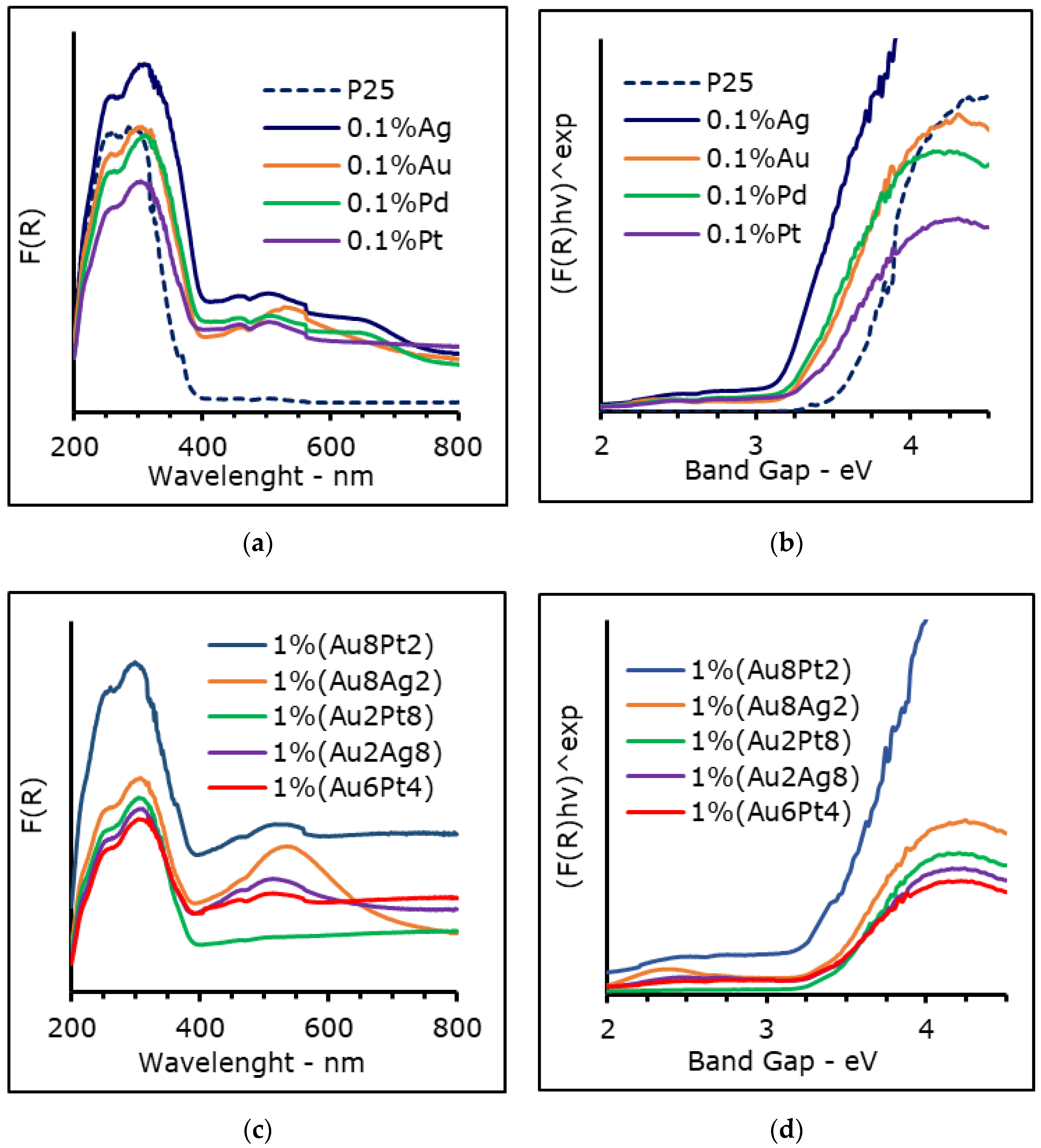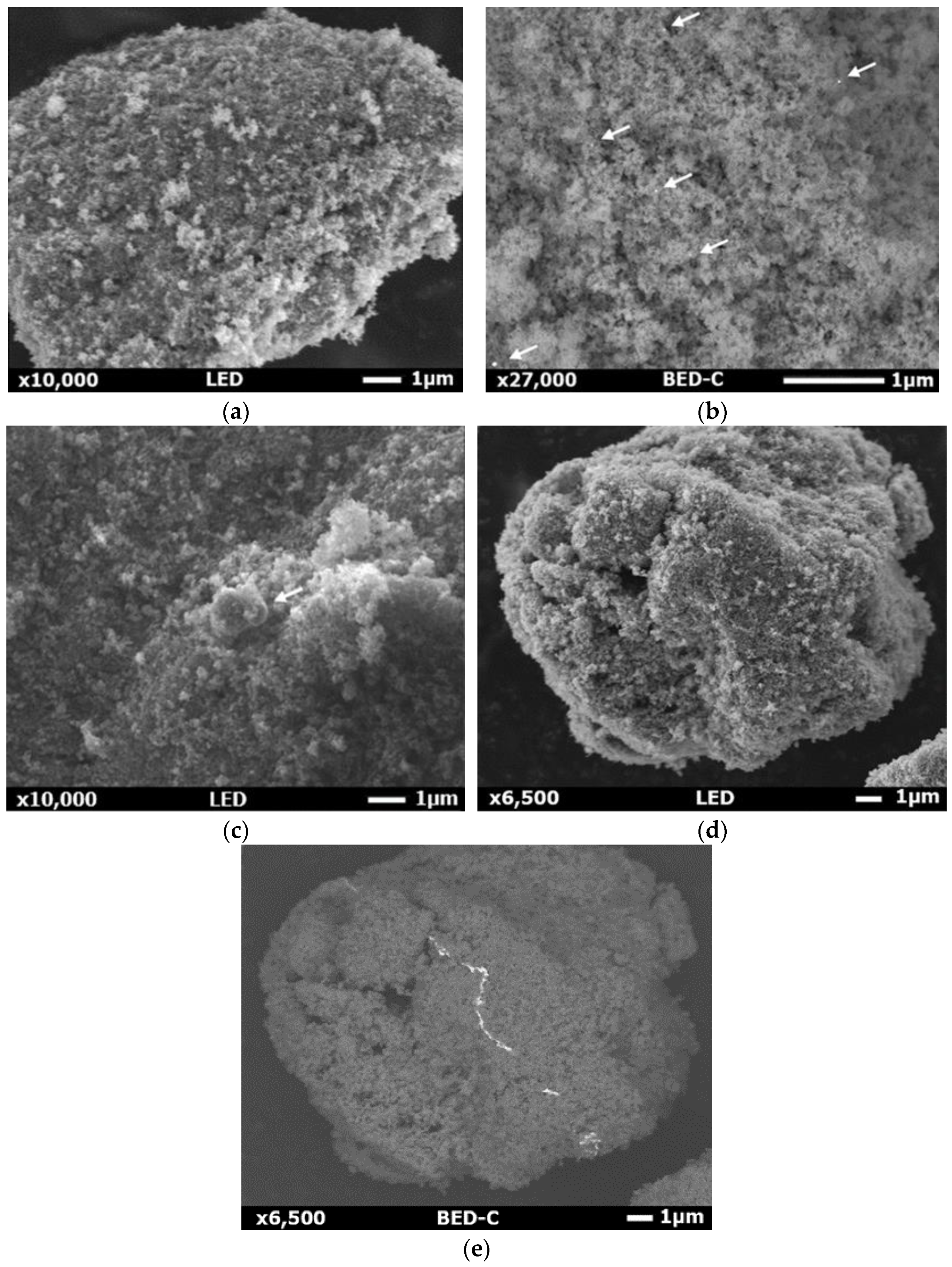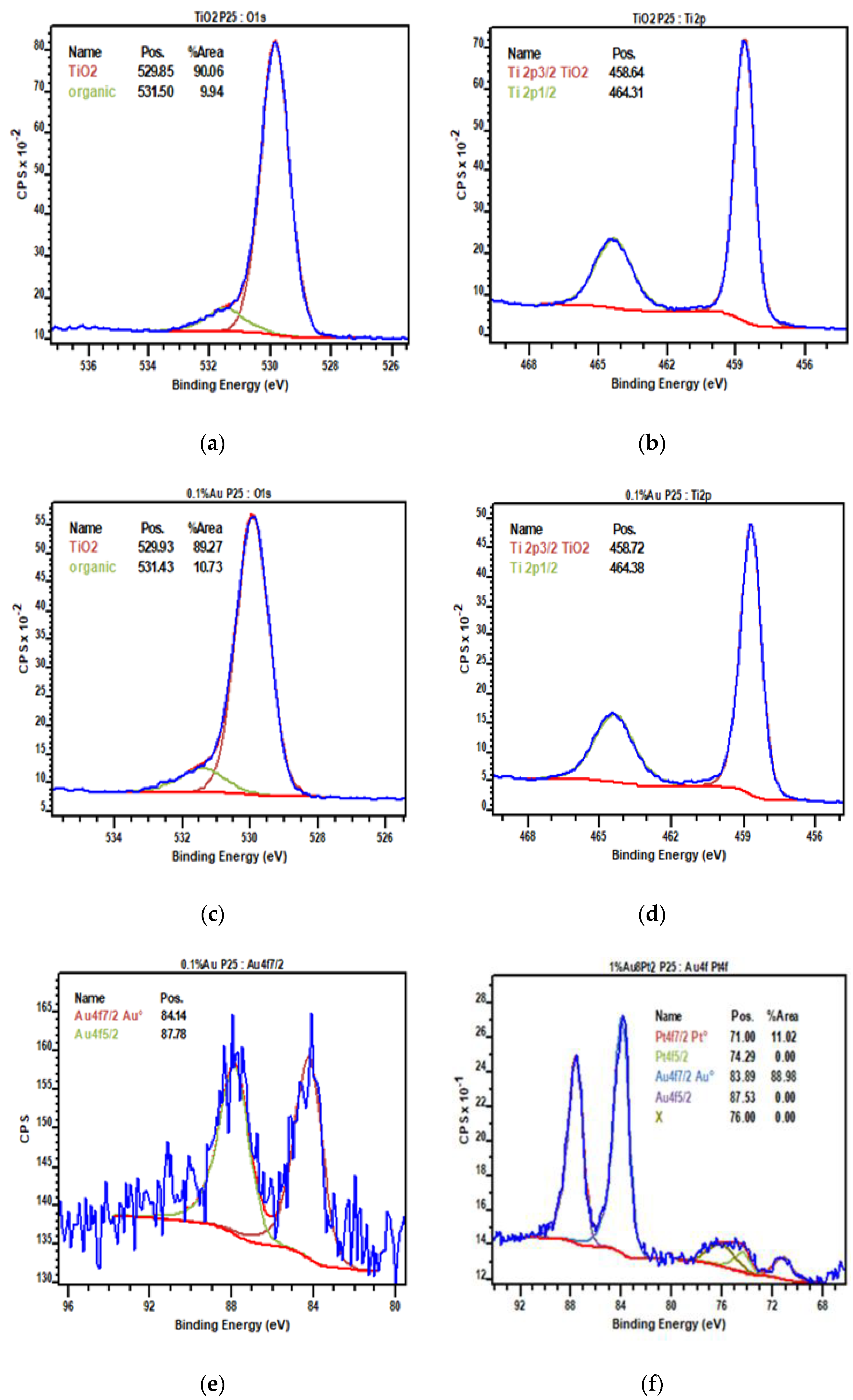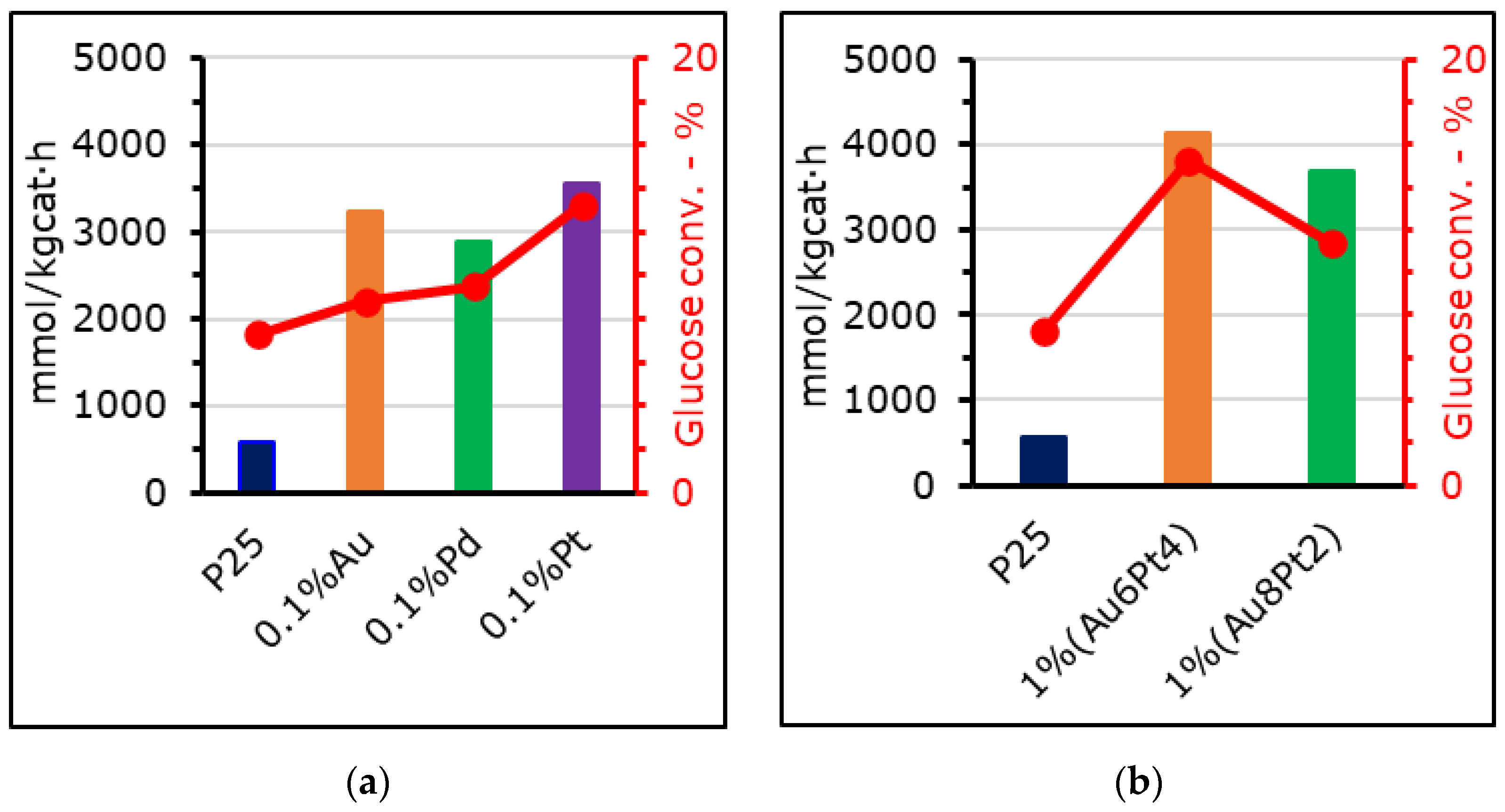Low Metal Loading (Au, Ag, Pt, Pd) Photo-Catalysts Supported on TiO2 for Renewable Processes
Abstract
:1. Introduction
2. Experimental
2.1. Catalyst Preparation
2.2. Characterization
2.3. Activity Test
3. Results and Discussion
3.1. Diffuse Reflactance UV-Visible (DR UV-Vis)
3.2. Textural Properties
3.3. Scanning Electron Microscopy and Energy-Dispersive X-ray (SEM-EDX)
3.4. X-ray Photoelectron Spectroscopy (XPS)
3.5. X-ray Diffraction (XRD)
3.6. Photo-Catalytic Tests
3.6.1. Photo-Reduction of CO2
3.6.2. Photo-Reforming
4. Conclusions
Supplementary Materials
Author Contributions
Funding
Institutional Review Board Statement
Informed Consent Statement
Data Availability Statement
Acknowledgments
Conflicts of Interest
References
- Fujishima, A.; Zhang, X.; Tryk, D.A. TiO2 photocatalysis and related surface phenomena. Surf. Sci. Rep. 2008, 63, 515–582. [Google Scholar] [CrossRef]
- Padmanabhan, N.T.; Thomas, N.; Louis, J.; Mathew, D.T.; Ganguly, P.; John, H.; Pillai, S.C. Graphene coupled TiO2 photocatalysts for environmental applications: A review. Chemosphere 2021, 271, 129506. [Google Scholar] [CrossRef] [PubMed]
- Hoffmann, M.R.; Martin, S.T.; Choi, W.; Bahnemann, D.W. Environmental Applications of Semiconductor Photocatalysis. Chem. Rev. 1995, 95, 69–96. [Google Scholar] [CrossRef]
- Asahi, R.; Morikawa, T.; Ohwaki, T.; Aoki, K.; Taga, Y. Visible-light photocatalysis in nitrogen-doped titanium oxides. Science 2001, 293, 269–271. [Google Scholar] [CrossRef] [PubMed]
- Kumar, S.G.; Devi, L.G. Review on modified TiO2 photocatalysis under UV/visible light: Selected results and related mechanisms on interfacial charge carrier transfer dynamics. J. Phys. Chem. A 2011, 115, 13211–13241. [Google Scholar] [CrossRef]
- Indrakanti, V.P.; Kubicki, J.D.; Schobert, H.H. Photoinduced activation of CO2 on Ti-based heterogeneous catalysts: Current state, chemical physics-based insights and outlook. Energy Environ. Sci. 2009, 2, 745–758. [Google Scholar] [CrossRef]
- Christoforidis, K.C.; Fornasiero, P. Photocatalytic Hydrogen Production: A Rift into the Future Energy Supply. ChemCatChem 2017, 9, 1523–1544. [Google Scholar] [CrossRef] [Green Version]
- Gaya, U.I.; Abdullah, A.H. Heterogeneous photocatalytic degradation of organic contaminants over titanium dioxide: A review of fundamentals, progress and problems. J. Photochem. Photobiol. C Photochem. Rev. 2008, 9, 1–12. [Google Scholar] [CrossRef]
- Fujishima, A.; Honda, K. Electrochemical photolysis of water at a semiconductor electrode. Nature 1972, 238, 37–38. [Google Scholar] [CrossRef]
- Pelaez, M.; Nolan, N.T.; Pillai, S.C.; Seery, M.K.; Falaras, P.; Kontos, A.G.; Dunlop, P.S.M.; Hamilton, J.W.J.; Byrne, J.A.; O’Shea, K.; et al. A review on the visible light active titanium dioxide photocatalysts for environmental applications. Appl. Catal. B Environ. 2012, 125, 331–349. [Google Scholar] [CrossRef] [Green Version]
- Bagheri, S.; Muhd Julkapli, N.; Bee Abd Hamid, S. Titanium dioxide as a catalyst support in heterogeneous catalysis. Sci. World J. 2014, 2014, 727496. [Google Scholar] [CrossRef] [PubMed] [Green Version]
- Landmann, M.; Rauls, E.; Schmidt, W.G. The electronic structure and optical response of rutile, anatase and brookite TiO. J. Phys. Condens. Matter 2012, 24, 195503. [Google Scholar] [CrossRef] [PubMed] [Green Version]
- Di Paola, A.; Bellardita, M.; Palmisano, L. Brookite, the least known TiO2 photocatalyst. Catalysts 2013, 3, 36–73. [Google Scholar] [CrossRef] [Green Version]
- Diffey, B.L. Solar ultraviolet radiation effects on biological systems. Phys. Med. Biol. 1991, 36, 299–328. [Google Scholar] [CrossRef]
- Humayun, M.; Raziq, F.; Khan, A.; Luo, W. Modification strategies of TiO2 for potential applications in photocatalysis: A critical review. Green Chem. Lett. Rev. 2018, 11, 86–102. [Google Scholar] [CrossRef] [Green Version]
- Kavitha, R.; Kumar, S.G. Review on bimetallic-deposited TiO2: Preparation methods, charge carrier transfer pathways and photocatalytic applications. Chem. Pap. 2020, 74, 717–756. [Google Scholar] [CrossRef]
- Zielińska-Jurek, A. Progress, challenge, and perspective of bimetallic TiO2-based photocatalysts. J. Nanomater. 2014, 2014, 208920. [Google Scholar] [CrossRef] [Green Version]
- Tauster, S.J.; Fung, S.C.; Baker, R.T.K.; Horsley, J.A. Strong interactions in supported-metal catalysts. Science 1981, 211, 1121–1125. [Google Scholar] [CrossRef] [Green Version]
- Leong, K.H.; Gan, B.L.; Ibrahim, S.; Saravanan, P. Synthesis of surface plasmon resonance (SPR) triggered Ag/TiO2 photocatalyst for degradation of endocrine disturbing compounds. Appl. Surf. Sci. 2014, 319, 128–135. [Google Scholar] [CrossRef]
- Liu, L.; Zhang, X.; Yang, L.; Ren, L.; Wang, D.; Ye, J. Metal nanoparticles induced photocatalysis. Natl. Sci. Rev. 2017, 4, 761–780. [Google Scholar] [CrossRef] [Green Version]
- Khore, S.K.; Kadam, S.R.; Naik, S.D.; Kale, B.B.; Sonawane, R.S. Solar light active plasmonic Au@TiO2 nanocomposite with superior photocatalytic performance for H2 production and pollutant degradation. New J. Chem. 2018, 42, 10958–10968. [Google Scholar] [CrossRef]
- Rosario, A.V.; Pereira, E.C. The role of Pt addition on the photocatalytic activity of TiO2 nanoparticles: The limit between doping and metallization. Appl. Catal. B Environ. 2014, 144, 840–845. [Google Scholar] [CrossRef]
- Hurum, D.C.; Agrios, A.G.; Gray, K.A.; Rajh, T.; Thurnauer, M.C. Explaining the enhanced photocatalytic activity of Degussa P25 mixed-phase TiO2 using EPR. J. Phys. Chem. B 2003, 107, 4545–4549. [Google Scholar] [CrossRef]
- Ayati, A.; Ahmadpour, A.; Bamoharram, F.F.; Tanhaei, B.; Mänttäri, M.; Sillanpää, M. A review on catalytic applications of Au/TiO2 nanoparticles in the removal of water pollutant. Chemosphere 2014, 107, 163–174. [Google Scholar] [CrossRef] [PubMed]
- Kowalska, E.; Janczarek, M.; Rosa, L.; Juodkazis, S.; Ohtani, B. Mono- and bi-metallic plasmonic photocatalysts for degradation of organic compounds under UV and visible light irradiation. Catal. Today 2014, 230, 131–137. [Google Scholar] [CrossRef]
- Gómez-Cortés, A.; Díaz, G.; Zanella, R.; Ramírez, H.; Santiago, P.; Saniger, J.M. Au−Ir/TiO2 prepared by deposition precipitation with urea: Improved activity and stability in co oxidation. J. Phys. Chem. C 2009, 113, 9710–9720. [Google Scholar] [CrossRef]
- Gallo, A.; Marelli, M.; Psaro, R.; Gombac, V.; Montini, T.; Fornasiero, P.; Pievo, R.; Dal Santo, V. Bimetallic Au–Pt/TiO2 photocatalysts active under UV-A and simulated sunlight for H2 production from ethanol. Green Chem. 2012, 14, 330–333. [Google Scholar] [CrossRef]
- Teoh, W.Y.; Mädler, L.; Beydoun, D.; Pratsinis, S.E.; Amal, R. Direct (one-step) synthesis of TiO2 and Pt/TiO2 nanoparticles for photocatalytic mineralisation of sucrose. Chem. Eng. Sci. 2005, 60, 5852–5861. [Google Scholar] [CrossRef]
- Usubharatana, P.; McMartin, D.; Veawab, A.; Tontiwachwuthikul, P. Photocatalytic process for CO2 emission reduction from industrial flue gas streams. Ind. Eng. Chem. Res. 2006, 45, 2558–2568. [Google Scholar] [CrossRef]
- Zhao, X.; Zhang, G.; Zhang, Z. TiO2-based catalysts for photocatalytic reduction of aqueous oxyanions: State-of-the-art and future prospects. Environ. Int. 2020, 136, 105453. [Google Scholar] [CrossRef]
- Indrakanti, V.P.; Kubicki, J.D.; Schobert, H.H. Photoinduced activation of CO2 on TiO2 surfaces: Quantum chemical modeling of CO2 adsorption on oxygen vacancies. Fuel Process. Technol. 2011, 92, 805–811. [Google Scholar] [CrossRef]
- Liu, L.; Li, Y. Understanding the reaction mechanism of photocatalytic reduction of CO2 with H2O on TiO2-based photocatalysts: A review. Aerosol Air Qual. Res. 2014, 14, 453–469. [Google Scholar] [CrossRef]
- Tseng, I.H.; Wu, J.C.S.; Chou, H.Y. Effects of sol-gel procedures on the photocatalysis of Cu/TiO2 in CO2 photoreduction. J. Catal. 2004, 221, 432–440. [Google Scholar] [CrossRef]
- Camarillo, R.; Tostón, S.; Martínez, F.; Jiménez, C.; Rincón, J. Enhancing the photocatalytic reduction of CO2 through engineering of catalysts with high pressure technology: Pd/TiO2 photocatalysts. J. Supercrit. Fluids 2017, 123, 18–27. [Google Scholar] [CrossRef]
- Jiao, J.; Wei, Y.; Chi, K.; Zhao, Z.; Duan, A.; Liu, J.; Jiang, G.; Wang, Y.; Wang, X.; Han, C.; et al. Platinum Nanoparticles Supported on TiO2 Photonic Crystals as Highly Active Photocatalyst for the Reduction of CO2 in the Presence of Water. Energy Technol. 2017, 5, 877–883. [Google Scholar] [CrossRef] [Green Version]
- Sescu, A.M.; Favier, L.; Lutic, D.; Soto-Donoso, N.; Ciobanu, G.; Harja, M. TiO2 doped with noble metals as an efficient solution for the photodegradation of hazardous organic water pollutants at ambient conditions. Water 2021, 13, 19. [Google Scholar] [CrossRef]
- Daskalaki, V.M.; Kondarides, D.I. Efficient production of hydrogen by photo-induced reforming of glycerol at ambient conditions. Catal. Today 2009, 144, 75–80. [Google Scholar] [CrossRef]
- Vaiano, V.; Iervolino, G.; Sarno, G.; Sannino, D.; Rizzo, L.; Murcia Mesa, J.J.; Hidalgo, M.C.; Navío, J.A. Production simultanée de CH2 et H2 par réformage photocatalytique d’une solution aqueuse de glucose sur un catalyseur Pd-TiO2 sulfaté. Oil Gas Sci. Technol. 2015, 70, 891–902. [Google Scholar] [CrossRef] [Green Version]
- P25—Evonik. Available online: https://corporate.evonik.com/en/products/search-products/pages/product-details.aspx?productId=43469&countryId=5023 (accessed on 3 December 2021).
- Bahadori, E.; Tripodi, A.; Ramis, G.; Rossetti, I. Semi-Batch Photocatalytic Reduction of Nitrates: Role of Process Conditions and Co-Catalysts. ChemCatChem 2019, 11, 4642–4652. [Google Scholar] [CrossRef]
- Bahadori, E.; Tripodi, A.; Villa, A.; Pirola, C.; Prati, L.; Ramis, G.; Dimitratos, N.; Wang, D.; Rossetti, I. High pressure CO2 photoreduction using Au/TiO2: Unravelling the effect of co-catalysts and of titania polymorphs. Catal. Sci. Technol. 2019, 9, 2253–2265. [Google Scholar] [CrossRef]
- Makuła, P.; Pacia, M.; Macyk, W. How To Correctly Determine the Band Gap Energy of Modified Semiconductor Photocatalysts Based on UV-Vis Spectra. J. Phys. Chem. Lett. 2018, 9, 6814–6817. [Google Scholar] [CrossRef] [PubMed] [Green Version]
- Kubelka, P.; Munk, F. Ein Beitrag zur Optik der Farbanstriche. Zeitschrift für Tech. Phys. 1931, 12, 593–601. [Google Scholar]
- Tauc, J.; Grigorovici, R.; Vancu, A. Optical Properties and Electronic Structure of Amorphous Germanium. Phys. Status Solidi 1966, 15, 627–637. [Google Scholar] [CrossRef]
- Bahadori, E.; Ramis, G.; Zanardo, D.; Menegazzo, F.; Signoretto, M.; Gazzoli, D.; Pietrogiacomi, D.; Di Michele, A.; Rossetti, I. Photoreforming of glucose over CuO/TiO2. Catalysts 2020, 10, 477. [Google Scholar] [CrossRef]
- Ramis, G.; Bahadori, E.; Rossetti, I. Design of efficient photocatalytic processes for the production of hydrogen from biomass derived substrates. Int. J. Hydroen Energy 2021, 46, 12105–12116. [Google Scholar] [CrossRef]
- Karkare, M.M. The Direct transition and not Indirect transition, is more favourable for Band Gap calculation of Anatase TiO2 nanoparticles. Int. J. Sci. Eng. Res. 2015, 6, 48–53. [Google Scholar]
- Zhang, J.; Zhou, P.; Liu, J.; Yu, J. New understanding of the difference of photocatalytic activity among anatase, rutile and brookite TiO2. Phys. Chem. Chem. Phys. 2014, 16, 20382–20386. [Google Scholar] [CrossRef]
- Reyes-Coronado, D.; Rodríguez-Gattorno, G.; Espinosa-Pesqueira, M.E.; Cab, C.; De Coss, R.; Oskam, G. Phase-pure TiO2 nanoparticles: Anatase, brookite and rutile. Nanotechnology 2008, 19, 145605. [Google Scholar] [CrossRef]
- Valencia, S.; Marín, J.M.; Restrepo, G. Study of the bandgap of synthesized titanium dioxide nanoparticules using the sol-gel method and a hydrothermal treatment. Open Mater. Sci. J. 2010, 4, 9–14. [Google Scholar] [CrossRef]
- Sandoval, A.; Aguilar, A.; Louis, C.; Traverse, A.; Zanella, R. Bimetallic Au-Ag/TiO2 catalyst prepared by deposition-precipitation: High activity and stability in CO oxidation. J. Catal. 2011, 281, 40–49. [Google Scholar] [CrossRef]
- Benz, D.; Felter, K.M.; Köser, J.; Thöming, J.; Mul, G.; Grozema, F.C.; Hintzen, H.T.; Kreutzer, M.T.; Van Ommen, J.R. Assessing the Role of Pt Clusters on TiO2 (P25) on the Photocatalytic Degradation of Acid Blue 9 and Rhodamine B. J. Phys. Chem. C 2020, 124, 8269–8278. [Google Scholar] [CrossRef] [Green Version]
- Cychosz, K.A.; Thommes, M. Progress in the Physisorption Characterization of Nanoporous Gas Storage Materials. Engineering 2018, 4, 559–566. [Google Scholar] [CrossRef]
- Debeila, M.A.; Raphulu, M.C.; Mokoena, E.; Avalos, M.; Petranovskii, V.; Coville, N.J.; Scurrell, M.S. The effect of gold on the phase transitions of titania. Mater. Sci. Eng. A 2005, 396, 61–69. [Google Scholar] [CrossRef]
- Sdanghi, G.; Schaefer, S.; Maranzana, G.; Celzard, A.; Fierro, V. Application of the modified Dubinin-Astakhov equation for a better understanding of high-pressure hydrogen adsorption on activated carbons. Int. J. Hydrogen Energy 2020, 45, 25912–25926. [Google Scholar] [CrossRef] [Green Version]
- Terzyk, A.P.; Gauden, P.A.; Kowalczyk, P. What kind of pore size distribution is assumed in the Dubinin-Astakhov adsorption isotherm equation? Carbon N. Y. 2002, 40, 2879–2886. [Google Scholar] [CrossRef]
- Debeila, M.A.; Raphulu, M.C.; Mokoena, E.; Avalos, M.; Petranovskii, V.; Coville, N.J.; Scurrell, M.S. The influence of gold on the optical properties of sol-gel derived titania. Mater. Sci. Eng. A 2005, 396, 70–76. [Google Scholar] [CrossRef]
- Du, X.; Huang, Y.; Pan, X.; Han, B.; Su, Y.; Jiang, Q.; Li, M.; Tang, H.; Li, G.; Qiao, B. Size-dependent strong metal-support interaction in TiO2 supported Au nanocatalysts. Nat. Commun. 2020, 11, 5811. [Google Scholar] [CrossRef]
- Tasbihi, M.; Kočí, K.; Edelmannová, M.; Troppová, I.; Reli, M.; Schomäcker, R. Pt/TiO2 photocatalysts deposited on commercial support for photocatalytic reduction of CO2. J. Photochem. Photobiol. A Chem. 2018, 366, 72–80. [Google Scholar] [CrossRef]
- Briggs, D.; Seah, M.P. Practical Surface Analysis by Auger and x-Ray Photoelectron Spectroscopy; John Wiley and Sons: Chichester, UK, 1983; ISBN 047126279X. [Google Scholar]
- Tougaard, S. Quantitative analysis of the inelastic background in surface electron spectroscopy. Surf. Interface Anal. 1988, 11, 453–472. [Google Scholar] [CrossRef]
- Proctor, A.; Hercules, D.M. Inelastic Background and Peak Area Determination in x-Ray Photoelectron Spectroscopy (Esca). Appl. Spectrosc. 1984, 38, 505–518. [Google Scholar] [CrossRef]
- Erdem, B.; Hunsicker, R.A.; Simmons, G.W.; David Sudol, E.; Dimonie, V.L.; El-Aasser, M.S. XPS and FTIR surface characterization of TiO2 particles used in polymer encapsulation. Langmuir 2001, 17, 2664–2669. [Google Scholar] [CrossRef]
- Kruse, N.; Chenakin, S. XPS characterization of Au/TiO2 catalysts: Binding energy assessment and irradiation effects. Appl. Catal. A Gen. 2011, 391, 367–376. [Google Scholar] [CrossRef] [Green Version]
- Yu, F.; Wang, C.; Ma, H.; Song, M.; Li, D.; Li, Y.; Li, S.; Zhang, X.; Liu, Y. Revisiting Pt/TiO2 photocatalysts for thermally assisted photocatalytic reduction of CO2. Nanoscale 2020, 12, 7000–7010. [Google Scholar] [CrossRef] [PubMed]
- Liu, J.; Ding, T.; Zhang, H.; Li, G.; Cai, J.; Zhao, D.; Tian, Y.; Xian, H.; Bai, X.; Li, X. Engineering surface defects and metal-support interactions on Pt/TiO2(B) nanobelts to boost the catalytic oxidation of CO. Catal. Sci. Technol. 2018, 8, 4934–4944. [Google Scholar] [CrossRef]
- Subramanian, V.; Wolf, E.E.; Kamat, P.V. Influence of metal/metal ion concentration on the photocatalytic activity of TiO2—Au composite nanoparticles. Langmuir 2003, 19, 469–474. [Google Scholar] [CrossRef]
- Dozzi, M.V.; Prati, L.; Canton, P.; Selli, E. Effects of gold nanoparticles deposition on the photocatalytic activity of titanium dioxide under visible light. Phys. Chem. Chem. Phys. 2009, 11, 7171–7180. [Google Scholar] [CrossRef]
- Scherrer, P. Nachrichten von der Gesellschaft der Wissenschaften zu Göttingen. Math. Klasse 1918, 2, 98–100. [Google Scholar]
- Bouzoubaa, A.; Markovits, A.; Calatayud, M.; Minot, C. Comparison of the reduction of metal oxide surfaces: TiO2-anatase, TiO2-rutile and SnO2-rutile. Surf. Sci. 2005, 583, 107–117. [Google Scholar] [CrossRef]
- Bahadori, E.; Tripodi, A.; Villa, A.; Pirola, C.; Prati, L.; Ramis, G.; Rossetti, I. High pressure photoreduction of CO2: Effect of catalyst formulation, hole scavenger addition and operating conditions. Catalysts 2018, 8, 430. [Google Scholar] [CrossRef] [Green Version]
- Conte, F.; Villa, A.; Prati, L.; Pirola, C.; Ramis, G.; Rossetti, I. Effect of metal co-catalysts and operating conditions on the product distribution and the productivity of the CO2 photoreduction. Ind. Eng. Chem. Res. 2022, 61, 2963–2972. [Google Scholar] [CrossRef]
- Pellegrino, F.; Sordello, F.; Mino, L.; Minero, C.; Hodoroaba, V.D.; Martra, G.; Maurino, V. Formic Acid Photoreforming for Hydrogen Production on Shape-Controlled Anatase TiO2 Nanoparticles: Assessment of the Role of Fluorides, {101}/{001} Surfaces Ratio, and Platinization. ACS Catal. 2019, 9, 6692–6697. [Google Scholar] [CrossRef]
- Kaneco, S.; Shimizu, Y.; Ohta, K.; Mizuno, T. Photocatalytic reduction of high pressure carbon dioxide using TiO2 powders with a positive hole scavenger. J. Photochem. Photobiol. A Chem. 1998, 115, 223–226. [Google Scholar] [CrossRef]
- Xie, S.; Zhang, Q.; Liu, G.; Wang, Y. Photocatalytic and photoelectrocatalytic reduction of CO2 using heterogeneous catalysts with controlled nanostructures. Chem. Commun. 2016, 52, 35–59. [Google Scholar] [CrossRef] [PubMed]
- Sanwald, K.E.; Berto, T.F.; Eisenreich, W.; Gutiérrez, O.Y.; Lercher, J.A. Catalytic routes and oxidation mechanisms in photoreforming of polyols. J. Catal. 2016, 344, 806–816. [Google Scholar] [CrossRef]
- Toe, C.Y.; Tsounis, C.; Zhang, J.; Masood, H.; Gunawan, D.; Scott, J.; Amal, R. Advancing photoreforming of organics: Highlights on photocatalyst and system designs for selective oxidation reactions. Energy Environ. Sci. 2021, 14, 1140–1175. [Google Scholar] [CrossRef]







| Photo-Catalyst | Direct Band Gap-eV | Indirect Band Gap-eV |
|---|---|---|
| P25 | 3.45 | 3.22 |
| 0.1 mol% Pd/P25 | 3.33 | 3.14 |
| 0.1 mol% Au/P25 | 3.20 | 3.14 |
| 0.1 mol% Pt/P25 | 3.21 | 3.18 |
| 0.1 mol% Ag/P25 | 3.21 | 3.10 |
| 1 wt% (Au8Pt2)/P25 | 3.22 | 3.19 |
| 1 wt% (Au6Pt4)/P25 | 3.21 | 3.22 |
| 1 wt% (Au2Pt8)/P25 | 3.20 | 3.19 |
| 1 wt% (Au8Ag2)/P25 | 3.22 | 3.24 |
| 1 wt% (Au2Ag8)/P25 | 3.21 | 3.21 |
| Photo-Catalyst | BET SSA–m2/g | Total Pore Volume–cm3/g | t-Plot Micropore Volume–cm3/g | BJH Adsorption Pore Width–nm |
|---|---|---|---|---|
| P25 | 47 | 0.257 | / | 35 |
| 0.1 mol% Pd/P25 | 57 | 0.511 | / | 39 |
| 0.1 mol% Au/P25 | 38 | 0.394 | / | 32 |
| 0.1 mol% Pt/P25 | 35 | 0.474 | / | 38 |
| 0.1 mol% Ag/P25 | 53 | 0.455 | 0.00039 | 34 |
| 1 wt% (Au8Pt2)/P25 | 52 | 0.480 | / | 42 |
| 1 wt% (Au6Pt4)/P25 | 45 | 0.467 | / | 38 |
| 1 wt% (Au2Pt8)/P25 | 33 | 0.296 | / | 36 |
| 1 wt% (Au8Ag2)/P25 | 51 | 0.509 | / | 43 |
| 1 wt% (Au2Ag8)/P25 | 41 | 0.513 | 0.00310 | 51 |
| Theoretical Bulk Metal Loading−mol% | XPS Loading−mol% | |||
|---|---|---|---|---|
| Photo-Catalyst | Au | Pt | Au | Pt |
| 0.1 mol% Au/P25 | 0.1 | / | 0.143 | / |
| 0.1 mol% Pt/P25 | / | 0.1 | / | 0.126 |
| 1 wt% (Au8Pt2)/P25 | 0.32 | 0.08 | 0.672 | 0.089 |
| 1 wt% (Au6Pt4)/P25 | 0.24 | 0.16 | 0.538 | 0.276 |
| Photo-Catalyst | Anatase/Rutile-% | Crystallite Size |
|---|---|---|
| P25 | 78/22 | 15(A)/26(R) |
| 0.1 mol% Au/P25 | 78/22 | 18(A)/28(R) |
| 0.1 mol% Pt/P25 | 77/23 | 18(A)/28(R) |
| 0.1 mol% Ag/P25 | 70/30 | 18(A)/28(R) |
| 1 wt% (Au2Pt8)/P25 | 73/27 | 16(A)/25(R) |
| 1 wt% (Au2Ag8)/P25 | 76/24 | 16(A)/24(R) |
| 1 wt% (Au8Ag2)/P25 | 73/27 | 16(A)/22(R) |
| Cat. | [Cat.] mg/L | Light Source | HS | Conditions | Products mmol/kgcat h | Ref. |
|---|---|---|---|---|---|---|
| 0.1 mol% Pt | 31 | UVA-157 W/m2 | Na2SO3 | 80 °C; 8 bar; pH 14 | HCOOH-9500 H2-4500 | This work |
| 1 wt% (Au2Ag8) | 31 | UVA-157 W/m2 | Na2SO3 | 80 °C; 8 bar; pH 14 | HCOOH-5500 H2-4400 | This work |
| 2 wt% Au | 5000 | Xe–620 W/m2 | i-PrOH | rt; 28 bar | CH4-0.5 HCOOH-<0.1 | [74] |
| 1.5 wt% Pt | 287 | UVC-8 W | none | rt | CH4-1.25 H2-1 CO-0.58 | [59] |
| 2 wt% Cu | 100 | UVC | none | rt; pH 13 | CH3OH-23 | [33] |
| 3 wt% CuO | 1000 | UVC–6 W | none | rt; pH 13 | CH3OH-230 HCOOH-0.5 HCHO-0.2 | [75] |
| Cat. | [Cat.] mg/L | Light Source | HS | Conditions | Products mmol/kgcat h | Ref. |
|---|---|---|---|---|---|---|
| 0.1 mol% Pt | 250 | UVA-157 W/m2 | glucose | 80 °C; 5 bar; pH 6.5 | H2-3500 | This work |
| 1 wt% (Au6Pt4) | 250 | UVA-157 W/m2 | glucose | 80 °C; 5 bar; pH 6.5 | H2-4100 | This work |
| 0.5 wt% Pd | 500 | UVA–10 W | glucose | rt; 1 bar | H2-208 | [38] |
| 0.2 wt% Au | 600 | Sunlight–145,000 lux | CH3OH | N/D | H2-400 | [21] |
| 0.5 wt% Au+0.5 wt% Pt | 2000 | UVA–125 W | CH3CH2OH | N/D | H2-7500 | [27] |
| 0.5 wt% Pt | 1300 | Xe–450 W | glycerol | 40 °C; pH 7 | H2-375 | [37] |
Publisher’s Note: MDPI stays neutral with regard to jurisdictional claims in published maps and institutional affiliations. |
© 2022 by the authors. Licensee MDPI, Basel, Switzerland. This article is an open access article distributed under the terms and conditions of the Creative Commons Attribution (CC BY) license (https://creativecommons.org/licenses/by/4.0/).
Share and Cite
Conte, F.; Rossetti, I.; Ramis, G.; Vaulot, C.; Hajjar-Garreau, S.; Bennici, S. Low Metal Loading (Au, Ag, Pt, Pd) Photo-Catalysts Supported on TiO2 for Renewable Processes. Materials 2022, 15, 2915. https://doi.org/10.3390/ma15082915
Conte F, Rossetti I, Ramis G, Vaulot C, Hajjar-Garreau S, Bennici S. Low Metal Loading (Au, Ag, Pt, Pd) Photo-Catalysts Supported on TiO2 for Renewable Processes. Materials. 2022; 15(8):2915. https://doi.org/10.3390/ma15082915
Chicago/Turabian StyleConte, Francesco, Ilenia Rossetti, Gianguido Ramis, Cyril Vaulot, Samar Hajjar-Garreau, and Simona Bennici. 2022. "Low Metal Loading (Au, Ag, Pt, Pd) Photo-Catalysts Supported on TiO2 for Renewable Processes" Materials 15, no. 8: 2915. https://doi.org/10.3390/ma15082915
APA StyleConte, F., Rossetti, I., Ramis, G., Vaulot, C., Hajjar-Garreau, S., & Bennici, S. (2022). Low Metal Loading (Au, Ag, Pt, Pd) Photo-Catalysts Supported on TiO2 for Renewable Processes. Materials, 15(8), 2915. https://doi.org/10.3390/ma15082915









